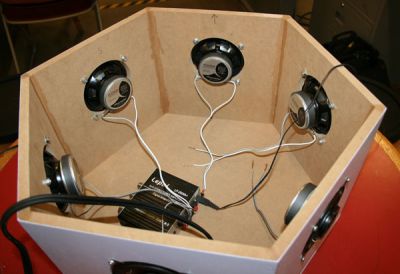
SMWC senior, Sherry Bube, and Rose-Hulman mechanical engineering students, Matthew Stephens and Anthony Shevchenko, stand with the interactive drum table during the construction phase.
When you hear a song, you tap your foot, maybe even bob your head a little or play a drum solo with your hands. We carry out these actions without even thinking about it because we are so in tune with the beat of the music. Rhythm is an essential element in music and is at the core of many of the methods used in music therapy. So when Saint Mary-of-the-Woods College (SMWC) senior music therapy major, Sherry Bube, saw a drum table at the Experience Music Project (EMP) Museum in Seattle, Wash., the idea for her senior project was born.
A drum table is electronic percussive instrument with a projection sound system that allows participants to play different instruments depending on where the drumhead is hit. There is currently no known drum table of this style or use for the therapeutic setting. But Sherry Bube’s project, B.E.A.T.! (Bring Everyone Around the Table), is about to change that.
For her senior project, funded by an $11,000 Independent Colleges of Indiana (ICI) Ball Venture grant, Bube developed an inter-collegiate collaboration between herself and two senior mechanical engineering students from Rose-Hulman Institute of Technology, Anthony Shevchenko and Matthew Stephens.
Together they will create an interactive percussive drum table that will utilize electronic and technological components, such as sensors and computer programming, to allow the drum to be adapted for a variety of uses within the therapeutic setting. Another important component of the instrument is the adjustable base that will allow for the drum to be made more accessible for individuals with physical disabilities, such as those with wheelchairs. This would be the first known drum table of this style with specific programming and technological capabilities toward a therapeutic use.
“It became apparent to me that branching out into this area of collaboration with individuals who are from other professions, delving into merging technology and musical instruments together, as well as looking for future research opportunities would be beneficial not only for the experience, but also for the clients that music therapy students engage with at various practicum sites in the community,” stated Bube. “It has been one of the best experiences I’ve had in terms of learning more about a topic area outside my typical subjects of study, collaborating with other professions, as well as the entire process of applying for grants and project development.”
Percussive instruments are easily interactive and provide tonal and rhythmic elements to the music. For example, individuals with Alzheimer’s disease have been found to respond to rhythm into the late stages of the disease, despite decreased mobility, coordination, social and communicative abilities. Rhythm is also basic to gait, speech and other physiological functions, and is valuable in addressing the various needs of clients in both group and individual therapeutic settings.

In the next phase of construction, the box that the speakers and wiring are housed in will be attached to an adjustable table designed to be easily transported.
“The interactive percussive drum table will increase the ability of the students in the growing Music Therapy programs at SMWC to become better equipped in working with instruments that utilize technology, and expand opportunity to address goal areas of clients who would benefit from the use of percussive instruments in music therapy sessions,” said Bube. “It will also serve as a model for electronic instrument development for a growing range of therapeutic uses.”
In March, Bube presented at the Great Lakes Regional Music Therapy Conference in Rosemont, Ill. In her presentation, Bube detailed the process of the B.E.A.T.! project, including grant application, research, collaboration and construction of the drum table.
“Sherry has been extremely professional and thorough in all aspects of the project,” said Sharon Boyle, SMWC associate professor and coordinator of the undergraduate program in music therapy and primary faculty advisor of the B.E.A.T.! project. “She dreams big, but she also follows through and makes things happen! She is an extraordinary student in many ways, but her leadership and implementation of this project have exceeded all my expectations.”
Having completed the stages of research and design, the team is currently in the construction and assembly phase. Stephens and Shevchenko expect to finish assembling the instrument by the end of May. After the project is completed, Bube and Boyle will train users, and the drum table will remain at SMWC. It will be utilized by music therapy students in clinical and classroom trainings, at practicum sites for music therapy sessions and in research of the effectiveness of percussive instruments with technological components.
“It is not typical for a student, in any program, to apply for and receive an $11,000.00 grant! This is a first for our program and I am hoping that other students will feel inspired to pursue other large projects after seeing all Sherry has accomplished,” said Boyle. “The fact that she chose an instrument design that could benefit the profession of music therapy, beyond our program, speaks to her sense of commitment to music therapy and to the clients we serve. All of this demonstrates that students in the SMWC Music Therapy program can achieve great things and we will support their big ideas!”
